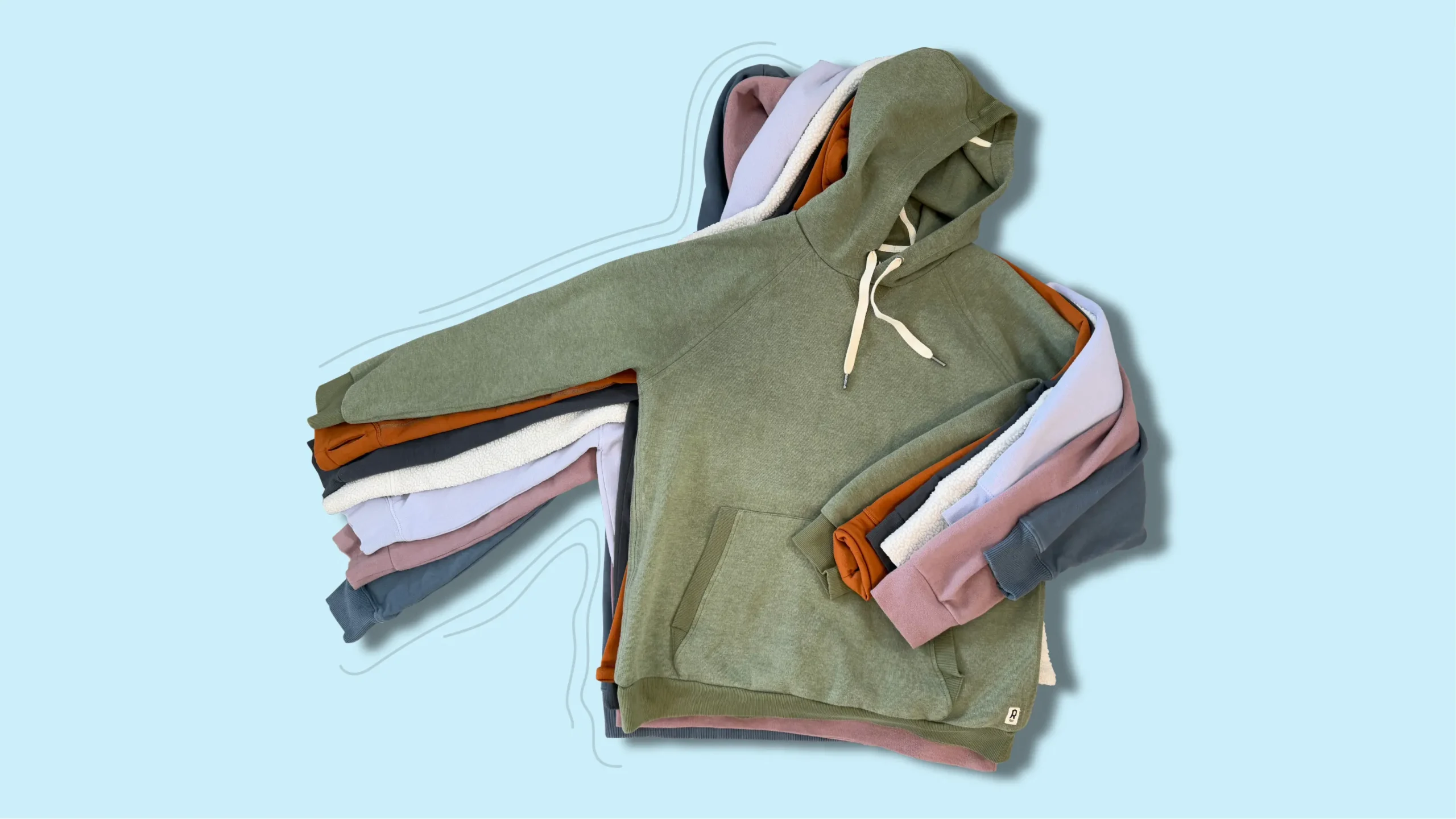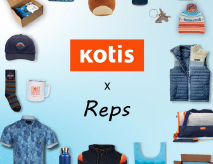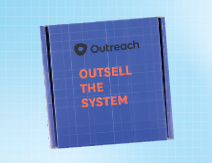The Best Eco-Friendly and Sustainable T-Shirts
Jacob Hoogerwerf | Table of Contents
Ah, the t-shirt: a staple of our industry and a blank canvas for your brand. Last year, more than $4.3B of custom shirts were printed and sold across the globe. This trend is unlikely to slow, with nearly 11% annual growth projected for the foreseeable future. It’s no wonder companies invest in this medium – t-shirts are one of the most popular, tied only with pens and drinkware. On average, tees are responsible for an impressive 3,400 impressions across their average lifespan of 14 months.
However, these shirts can come at a sharp cost to our environment. In our blog post exploring the sustainable ways to create swag, we looked at the impact of creating a single shirt. The standard, most affordable, cotton tees require a staggering 713 gallons of water just to grow, harvest, and dye the material. Each year, enough cotton is grown and processed to create nearly 27 t-shirts for every person on our planet. To say the least, the stakes are high when it comes to choosing your tees.
We don’t want you to stop making swag. By investing in fewer, but higher-quality products, you can leave a lasting impression on your people and the planet. Most companies are already planning to order custom t-shirts this year, so let’s take a look at products and brands to invest in that are mitigating their environmental impact through clever new materials, innovative processing methods, and ethical production guidelines.
The Best Eco-Friendly and Sustainable T-Shirts
Jacob Hoogerwerf | Table of Contents
Ah, the t-shirt: a staple of our industry and a blank canvas for your brand. Last year, more than $3B of custom shirts were printed and sold across the globe. This trend is unlikely to slow, with nearly 10% annual growth projected for the foreseeable future. It’s no wonder companies invest in this medium – t-shirts are one of the most popular, tied only with pens and drinkware. On average, tees are responsible for an impressive 3,400 impressions across their average lifespan of 14 months.
However, these shirts can come at a sharp cost to our environment. In our blog post exploring the sustainable ways to create swag, we looked at the impact of creating a single shirt. The standard, most affordable, cotton tees require a staggering 713 gallons of water just to grow, harvest, and dye the material. Each year, enough cotton is grown and processed to create nearly 27 t-shirts for every person on our planet. To say the least, the stakes are high when it comes to choosing your tees.
We don’t want you to stop making swag. By investing in fewer, but higher-quality products, you can leave a lasting impression on your people and the planet. Most companies are already planning to order custom t-shirts this year, so let’s take a look at products and brands to invest in that are mitigating their environmental impact through clever new materials, innovative processing methods, and ethical production guidelines.
OUR PREMIUM PICK
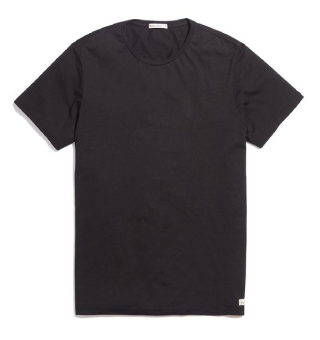
This super soft material sourced from recycled beech wood makes the ultimate premium tee for any project. By focusing on creating the “perfect” tee, Marine Layer’s shirts will stick around for years to come. When it’s finally time to say farewell, Marine Layer offers a garment recycling program.
As low as: $45
Colors:
The Signature Crew Shirt from Marine Layer isn’t just our favorite sustainable t-shirt, it’s the best shirt we’ve ever tested. Marine Layer has crafted a unique, buttery-soft material that feels just as good on wear number one as it does months later (yes we test these things for months). The signature offers a more open neck, once again contributing to its premium look and feel This is the type of shirt that gets worn daily, giving your brand maximum exposure and impressions.
Sustainability is at the heart of Marine Layer’s brand promise. Their signature tee is made partly from recycled beech wood (50%), which gives each shirt its unique softness. The remainder of the product is made from cotton (50%). Each garment is produced in the United States at one of their West Coast facilities in San Francisco or Los Angeles, which not only bodes well for ethical labor practices, but also cuts down on emissions from transporting raw materials and product.
If you want to up your eco game, Marine Layer also offers shirts from their re-spun collection, made from recycled tees that you can send in (for a $5 credit per shirt, even!). These Re-Spun tees remove the growing and harvesting component of production, which is responsible for upwards of 75% of the total eco impact, making them especially light on the environment.
If you order is above 144 shirts, Marine Layer offers custom dying to match any pantone (the only brand we tested that offers this). However, if you’re under that mark, the stock colors are limited to just four.
OUR PICK
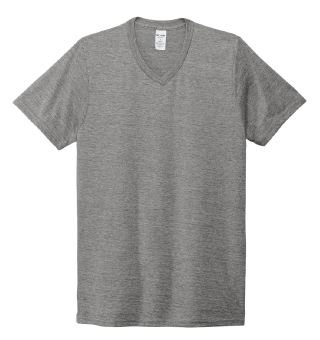
Made from recycled water bottles, beech wood (Tencel Modal), and USA-grown cotton, this tri-blend shirt offers very soft fabric and an ultra-premium feel, at a more affordable price point. Allmade’s chic V-neck design and fit is sure to delight.
As low as: $20.32
Colors:
The story behind Allmade is also the reason why the shirt is so great. Born out of a desire to make a better shirt to print on, a trip to Haiti exposed the hardships created by the apparel industry – both on the planet and the people making our products. Each Allmade shirt is made from a six-pack of recycled bottles (50%), sustainable beech wood for softness (25%), and organic USA cotton (25%).
This mix of materials not only alleviates environmental impacts, but it also produces an amazingly soft and well-made shirt. The shirt is lightweight, but not sheer. Furthermore, the Allmade shirt withstood nearly a dozen trips to the washing machine and dryer and is still as soft and comfortable as it was on day one. This shirt carries all the benefits of a brand name without the higher price point and is an optimal mix of sustainable materials with a premium experience.
As we’ve touched on, Allmade shirts are products you can invest in with confidence. An order of 100 tri-blend shirts (as opposed to standard cotton tees) would save nearly 33,000 gallons of water, result in 275 pounds less of CO2 pollution, and keep 22 pounds of plastic out of the ocean, according to their calculator. While many brands claim to be eco-conscious, these are the types of metrics worth looking at to ensure meaningful impacts are being made.
PREMIUM PICK

The Marine Layer Signature Crew Shirt
Buttery soft, our favorite t-shirt to date
This super soft material sourced from recycled beech wood makes the ultimate premium tee for any project. By focusing on creating the “perfect” tee, Marine Layer’s shirts will stick around for years to come. When it’s finally time to say farewell, Marine Layer offers a garment recycling program.
Material: 50% Supima Cotton + 50% Micro Modal, which comes from sustainably grown beechwood trees
As low as: $45
Colors:
OUR PICK

Allmade Tri-Blend V-Neck Shirt
Ideal mix of sustainability and comfort
Made from recycled water bottles, beech wood (Tencel Modal), and USA-grown cotton, this tri-blend shirt offers very soft fabric and an ultra-premium feel, at a more affordable price point. Allmade’s chic V-neck design and fit is sure to delight.
Material: TRI-BLEND 4.2-ounce, 50% Repreve® polyester from recycled plastic bottles/25% organic, US-grown cotton/25% Tencel™ Modal
As low as: $20.32
Colors:
![]()
![]()
![]()
![]()
![]()
![]()
![]()
![]()
![]()
BONUS PICK

Known Supply Crew T-Shirt
Amazing story, connecting people and products
At the intersection of sustainability and transparency is Known Supply – you can feel good about investing in their products. Constructed entirely out of organic cotton and made responsibly by adults, you’re able to put a face to the name of the “maker” of your shirt with a nametag on each garment.
Material: 100% Organic Cotton
Colors:
Other products we tested
It should not come as any surprise that there are a lot of t-shirts out there. As a distributor, our goal is to create meaningful merchandise that leave a positive impact on people and the planet – and this starts with the products we print on.
For this SwagLab, we looked at 13 unisex and women’s tees with a range of sustainability contributions. Throughout this article, we hope it becomes clear there is no set blueprint for sustainability. From 100% cotton tees to recycled polyester (which is made most often from coal or petroleum), there are a range of opportunities to lessen your footprint.
Each shirt had to meet several impact-based requirements. We want to avoid products and brands participating in greenwashing (that is, trying to appear as if a product is “green” or eco-focused when in reality, it doesn’t move the needle). These considerations included:
- Materials: the growing and harvesting of the raw materials should be more sustainable than similar products by either:
-
- a) having a lesser impact than standard materials (i.e. 100% cotton), or
-
- b) reusing materials in order to reduce waste (i.e. recycled bottles or fabric).
-
- Longevity: the durability and quality of each shirt should exceed expectations of similar products to ensure a longer lifespan.
- Ethical Production: each product must be made responsibly, both in the standards for mitigating adverse environmental impacts as well as meeting high requirements for their employees and factory conditions. Bonus points for a public and traceable supply chain.
Two of our options (made by Known Supply and Patagonia) both leaned into responsible farming and cultivation to create 100% organic cotton tees. These shirts seek to reduce their footprint by growing cotton (which usually requires an incredible amount of water and treatment) with low-impact methods, including the elimination of harmful pesticides.
The rest of the shirts use a variety of alternative materials to lessen their footprint. We have a whole section on material impact below, but some notable mentions include the Royal Apparel Recycled Jersey Tee as well as the District Re-Tee. While these shirts didn’t quite reach our top choices in terms of fit and feel, they’re both made entirely out of upcycled material, requiring no additional growing and harvesting. If your goal is to produce garments with the least possible footprint, these are great choices.
Contents
Why get eco tees?
Our research
Premium pick: The Marine Layer Signature Crew Shirt
Our pick: Allmade Tri-Blend V-Neck Shirt
Bonus pick: Known Supply Crew T-Shirt
Other products we tested
A look at material impact
• Cotton
• Polyester
• Modal
• Blends
Decoration tips
Why trust Kotis
Why get eco-tees?
Normally, this section is reserved for talking about the benefits of a product category, but chances are your team is already planning on investing in t-shirts this year. Instead, we hope this section can help inspire you to invest in sustainable alternatives for your next purchase.
While often marginally more expensive, eco-tees tend to provide a premium experience that is likely to wow your audience. As described in our sustainable swag blog post, the goal of producing branded merch shouldn’t be to maximize quantity, but rather to provide the best experience to the people who receive the item. By doing so, you can actually improve your overall brand reach, even with a smaller product count. Investing in higher quality items means more time spent with a product and a deeper relationship with your brand.
When it comes to an environmental impact, a more responsible product should come at a higher cost. Decades of tight competition in our industry has led to a race to the bottom in terms of product quality as well as harvesting and labor practices. Not only has there been an impact on our planet, but also a noticeable decline in product quality and longevity.
The products we’ve chosen to highlight in this piece are much more likely to withstand the test of time. In Patagonia’s decision to restrict their products for decoration, they cite product waste as the biggest contributor. Products that are used for just two additional years offset their environmental footprint by 82%, since you won’t be purchasing additional products.
At the end of the day, your goal with branded merchandise investment should be to create products that won’t be worn once, but rather stand as a staple in your giftees wardrobe for years to come. This requires a higher initial investment, but this responsible spend will result in years of exposure and a more eco impact.
Our research
We’re always proud of our research for SwagLabs, but this one stands out as our largest effort to date. Over the course of the last 18 months, our largest group yet tested both a unisex and women’s option. This testing period, of course, overlapped largely with a global pandemic that saw us wearing more t-shirts than ever as we worked from home with comfort becoming an even higher priority.
Throughout the testing, each product was worn and washed dozens of times, and ultimately judged on fit, washability, breathability, look, feel, and inclusivity (sizes and color options). Unlike many of our previous tests, where we could rely on hard data (i.e. temperature graphs), this test was more subjective. By relying on the diverse opinions and preferences of our tester team, we’re confident that you’ll enjoy these picks.
This specific SwagLab also weighed the merits of the physical product itself with the environmental footprint that it took to get it to our doorstep. Once again, as a reminder, approximately three-quarters of an item’s footprint comes from the cultivation, harvesting, and production of the raw materials, so that remained the focus of this aspect of our testing.
A look at material impact
Look at the label of your shirt you’re wearing right now. What’s it made of? Chances are you’ll see familiar words like “cotton” and “polyester”, but there also might be terms you’re less familiar with – Modal, Monocel, Tencel, or even hemp. What’s this stuff doing in our clothes? Over time, for both economics and environmental reasons, the stuff to make our clothes has changed.
A quick history of fabrics: historians are fairly confident that we’ve been using textiles to make clothes for nearly 100,000 years and for much of the last 7,000 years or so, there were few innovations in the ways people made these fabrics. Linen, cotton, wool, and silk have been used by people across the world for hundreds of generations. Fast forward to much more recently, and now there’s an explosion of materials available. Even common household names like nylon and spandex didn’t exist just 100 years ago.
As time has gone on, we’ve begun to understand how these materials affect both the garments as well as the people who wear them. You can split these materials in two buckets: organic and synthetic. Organic material is of course grown from the ground, while synthetic material is synthesized, often from uglier origins including coal or oil. However, just because something is grown doesn’t mean it’s inherently “greener” than a synthetic textile. Many plants, especially cotton, require tons of energy to grow.
For this SwagLab, we’ve leaned into our independent research as well as the Higg MSI index, which takes a holistic look at a specific material’s impact from conception to disposal.

The above graphic should help illustrate several key takeaways:
- “Virgin”, or material that is brand new, is nearly always the highest impact material. It takes a ton of water and resources to grow things from scratch. However, virgin material is often the cheapest. This means that the basic heavy cotton tees that make up a large share of orders in our industry are causing more strain on the environment.
- Synthetic doesn’t equal bad; clothes made from coal actually have the potential to do a lot of good since they’re generally softer, more durable, and can withstand the test of time. Some materials that seem green (i.e. bamboo), have more impact on the environment due to high cultivation costs.
- Both organic and synthetic materials can be recycled. Investing in 100% recycled materials is the most effective way to mitigate your footprint when producing merchandise.
- Many of the newer materials (i.e. Modal, Tencel) are somewhere in the middle, more on those next.
The biggest criteria for the footprint of a shirt is the material it’s made of. Below, we go into detail on some of the most popular textiles from the shirts we looked at.
Cotton
Cotton is still the most common textile in our clothes today. Last year, the United States produced 20 million bales of cotton (each bale can produce 1,200 tees) making America the largest exporter on the plant. The vast majority of cotton is sent to India and China where it is processed into a usable textile.
Cotton is versatile and relatively cheap and is the most common material in the majority of budget tees. Unfortunately, the accessibility and low cost of cotton doesn’t make it an eco-friendly material. Cotton requires a lot of water to grow, approximately 2,700 liters (713 gallons) per shirt. That’s how much water you drink every 2.5 years, all for a single tee.
The impact of cotton isn’t just one we’ll feel in the far future, it’s already here. In Central Asia, which now produces the majority of global cotton, the Aral Sea (previously the fourth largest saline lake in the world), has completely dried up as farmers siphoned water to feed thirsty cotton plants. Asian farmers, particularly those in India, have also been fraught for decades dealing with Bt cotton. This topic is beyond the scope of this SwagLab, but farmers have alleged for decades that this specific genetically modified strain of cotton (created by Monsanto) has caused serious health issues, including a disputed-claim of increased suicides by farm workers who handle the seeds.
All of this is to say that cotton is a difficult textile to navigate. Despite its shortcomings and serious environmental concerns, it still is the foundation for so many of our products and apparel. Its usefulness and affordability often cause manufacturers to turn a blind eye to how it is produced. It’s an impossible crop to avoid, and that’s okay. All of our top picks include cotton in their material mix, so let’s take a look at how to responsibly utilize cotton products.
Today, new techniques are being used to lessen the impact of cotton production, including the new trend of organic, USA cotton. These plants are grown in the United States, where environmental protection laws are somewhat stronger than abroad and are grown without the use of harmful pesticides. So, as a rule of thumb, invest in USA-grown cotton (bonus points for organic material) and if possible, lean into recycled cotton to reap the benefits of the textile without requiring additional material to be grown.
Polyester
Polyester is a synthetic material, created by processing petroleum, air, and water. Like all materials, the environmental cost comes from both harvesting the raw goods (in this case, oil or coal) and through the industrial process. Despite being made from fossil fuels, which are clearly a negative as we move towards a greener future, polyester actually has a lower impact on the environment during production than many organic materials, including cotton.
Since polyester is a plastic, it feels a bit different on the skin than cotton. Polyester is often more breathable and lightweight than its cotton counterpart. If you’ve worn an athleisure item or jersey in the past, you’ll be familiar with the feeling of 100% synthetic material. Today, polyester is generally mixed with other organic and synthetic materials to create a blend (more on this shortly). Additionally, polyester is heavily used outside of apparel, especially for furniture and outdoor goods.
Like cotton, polyester can actually be recycled fairly easily and turned into new garments without the impact of new production. However, a major downside to polyester (and all synthetic materials) is its inability to breakdown fully. Plastic is remarkably durable: an upside during the useful life of a product, but a risk once it hits the landfill. Unlike cotton tees, which will eventually decompose like all organic materials, polyester will take far longer to fall apart (up to 200 years!). There’s also the risk of microplastics, which we do not yet fully understand. Recent studies have suggested that as many as a million fibers of small plastic may fall of each time an item is washed. Again, we don’t know exactly the long-term effects of this on our eco-system, but we should be weary of any product that introduces pollutants to our oceans and water supplies.
Modal
Enter the hybrid! Modal (as well as Lyocell, Tencel, and Monocel) is a semi-synthetic material that combines organic materials with chemical liquids used to break down the raw materials into pulps and fibers used to produce textiles. These days, all the rage is about Modal and its counterpart, Micromodal. Known for their unbelievable softness, both types of fabrics utilize beech wood, a material historically used for firewood, native to Europe, Asia, and North America.
Beech trees, like every raw material in the world, has its pros and cons. It uses 50% less water to produce than cotton and unlike the cotton plant, trees are generally carbon negative since they absorb carbon emissions created by other activities. To be clear, however, within the scope of harvesting trees for production in garments, modal is not carbon negative or even carbon neutral. It still takes more in emissions to grow and process this material than the absorption benefits from the tree. That being said, it’s estimated that Modal’s impact has 60% less of a carbon footprint to comparable materials, including cotton.
Modal is extremely soft and comfortable, even in low quantities. Our two top picks leverage modal for almost half of their raw materials, and they’re absurdly soft. As a result, modal is most commonly used in underwear and pajamas. Like cotton, modal products are biodegradable and unlike its fully synthetic counterparts, microplastics are not a concern.
Like any wood-based material, deforestation must remain a concern. The beech tree population has declined significantly due to disease and harvesting, and they take decades to grow to a useful size. Ensuring that a company is committed to replanting practices is a way to mitigate long-term risks. Tencel, a firm that produces large quantity of modal yarn, adheres to strict standards, so look for that brand name in the material list of your products.
Blends
As you consider the options, you’ll find that most shirts with an eco-focus aren’t made entirely from one material, but generally a blend of raw textiles. Both of our top picks use a combo of modal and cotton (as well as recycled polyester, for the Allmade shirt). By mixing numerous materials together, manufacturers are able to utilize the strengths of each, while mitigating the potential downsides by investing exclusively in a single material.
Blended shirts are often the softest and most durable, which is why they’re our favorite type of shirt. They tend to have a more heathered or weathered look than a solid shirt (which we enjoy for its fashion forward leaning but isn’t always what someone is in the market for). One drawback is the potential for recycling difficulties as some garment recyclers are unable to process and sort the varied materials in each blend and therefor send the shirt to the landfill.
A note on alternative materials (flax, bamboo, hemp)
Cotton and beech wood aren’t the only materials you can grow to make shirts. Flax, bamboo, and hemp all make a nice t-shirt, and all have various levels of carbon footprints during their production. In this test, we only looked at a limited number of t-shirts, including one made from a bamboo/cotton blend. In the future, we look forward to testing additional products, especially those made from hemp, which shows a ton of promise in reducing impact. We will update our guides and recommendations accordingly.
BONUS PICK

At the intersection of sustainability and transparency is Known Supply - you can feel good about investing in their products. Constructed entirely out of organic cotton and made responsibly by adults, you’re able to put a face to the name of the “maker” of your item. Each shirt has a label showing the name of the person who made your shirt and a code to read their story.
Colors:
Known Supply has a simple philosophy: you should know where your products came from. They’re part of a movement of individuals, companies and partners who care about honoring and celebrating those who make our clothing.
They use 100% organic cotton to produce their products and are stewards in our industry for fair and transparent labor practices. While cotton does require excessive water relative to alternative materials, the cotton is produced organically and locally to where the shirts are made, thus eliminating all harmful pesticides and reducing the impact felt by transportation of raw goods.
Each shirt has the name of the “maker” of your product. On Known Supply’s site, you can read the bio and background of your maker. Madhab produced our garments and you can read a little more about him. “By all accounts, Madhab, who is a ten-year veteran of the garment industry, lights up any room that he enters and is a force for positive.” By knowing who labored on your shirt, you develop a deeper relationship and gratitude to your product.
And you don’t need to take our word for their great product and labor standards. Known Supply is a B-Corp and Free Trade Certified, so you can feel confident in investing in their products.
Decoration tips
To go deeper on design and decoration tips, we’re developing a guide on how to extend the life of your logo’d merch. In the meantime, as is often the case, “less is more”. Take a look at your t-shirt drawer. On top there are probably a handful of shirts you wear a lot, and underneath are a pile of your forgotten collection. Do the ones on top have massive logos? Probably not. Let the message you’re promoting (or the brand you’re investing in) be the star of the show, and your logo be the supporting character.
When working on the graphics that will dawn your shirt, consider how it can match the tee’s eco vibe. Add a distress so the print is more faded. Choose colors that are more neutral or earthy. Go with a hand drawn style design (if you don’t have illustrators on hand for this, we do!)
We also love a good woven label. Even though it’s small and subtle, it adds a nice brand pop and raises the perceived value of the overall piece. Next time you’re wearing a fav brand, notice how well they use those small pieces of fabric.
A note on water-based inks
When it comes time to screen print on your shirt, consider something that pairs well with your eco shirt in both design and ink choice. We love to use water-based inks whenever possible. Unlike other inks (plastisol) that contain PVC and phthalates, water base ink uses 100% biodegradable pigments suspended in a water solution. Water base inks release far fewer emissions in manufacturing, require no harsh solvents in cleaning, and stay bound to the fibers of the shirt longer than any alternative ink. The best part is the print feels like it’s part of the shirt, soft to the touch.
Why trust Kotis
We have a long history with t-shirts. For over a decade, they’ve been the bread and butter of our business and we’ve helped countless businesses tell their story by decorating tees. Over the years, we’ve produced and decorated well over a million shirts. As the need for sustainability has become more apparent, our business has fought for better to push further into sustainability.
Over the last year, we’ve created several recommendations to create more eco-conscious products for our clients, including a blog post and product guide and our print shop director was recognized for sustainable printing practices. Sustainability serves as a key part of our business that we hope to keep expanding on.
